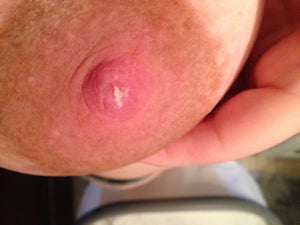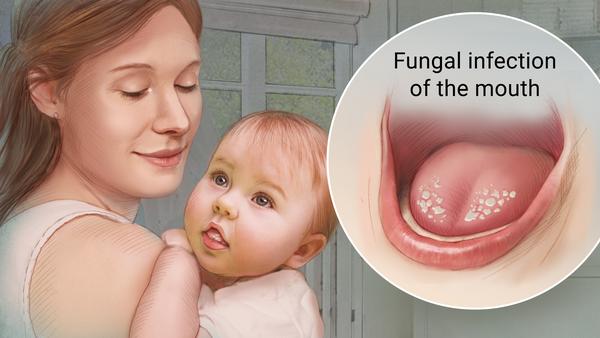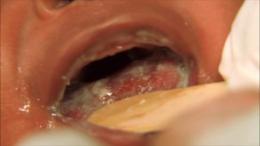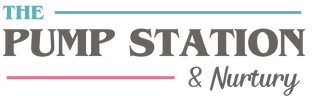What is Thrush?
Thrush is an irritating yeast infection caused by an overgrowth of the organism Candida Albicans, which is the same yeast organism that causes vaginal yeast infections. Although this fungus occurs naturally in all human bodies, certain conditions allow it to grow unchecked; so while it's called an “infection” it’s really an “overgrowth” of Candida, a normal part of the flora found on skin. It can appear on mom’s nipples and areolas and baby’s mouth and diaper area. It is SAFE for both mom and baby to continue breastfeeding while treating thrush.
What Can Cause Thrush?
- Antibiotics given to mom or baby can cause an imbalance in the normal flora responsible for keeping yeast from proliferating.
- Nipple pain, cracked nipples or other trauma caused by a poor latch.
- use of oral contraceptives
- diabetes
- Compromised immune system.
How Do I Know if I Have Thrush?
Mom's Symptoms:
The mother may experience a sudden onset of acute nipple pain during feedings, which may continue even after the feeding is finished. Often it can occur several weeks after birth at a time where breastfeeding is going well. The pain is often described as "burning" or intense itching on one or both breasts, commonly on the nipples, and does not improve with better latch or positioning techniques. Shooting pain deep within the breast may also occur and sometimes radiate into the back, shoulder or armpit.
Appearance: Nipples and areolas often become bright pink. They may appear shiny or flaky and may have a rash of tiny blisters extending onto the areola. There also may be semicircular cracks where the nipple base meets the areola. Occasionally there are no apparent symptoms. A mother could also be experiencing a vaginal yeast infection. Please note, thrush in breastfeeding moms is often misdiagnosed. Make an appointment with an IBCLC to rule out other common causes of nipple and breast pain.

Baby's Symptoms:
Infants normally have a white coating on their tongue, particularly after feedings. But with thrush an infant will have creamy white dots or patches that appear inside the cheeks, on the gums, tongue and lips. These patches look like "spit-up," but it does not wipe or scrape away easily without causing bleeding. In addition, the baby may have a fiery red diaper rash that does not respond to OTC diaper rash remedies. The baby may be excessively gassy, repeatedly pulling off the breast during feedings. The baby may even refuse to nurse altogether because his mouth is sore.


How is Thrush Treated?
We recommend calling BOTH your OB and your pediatrician and treating both mom and baby simultaneously even if one of you doesn’t have symptoms. This prevents the infection from being passed back and forth from mom to baby. Treat both mom and baby for 14 days to prevent reinfection, even if symptoms improve.
Treatment for Mom:
- A high-quality probiotic such as BioGaia Elactia MUM can help re-establish microbial balance.
- Over the counter topical antifungal medications: Mycolog ointment or vaginal yeast medications such as Monistat 7, Lotrimin AF, or Micatin. (Nystatin is no longer recommended for treating topical thrush on moms). Apply to affected area after feeding/pumping. If all of the ointment is not soaked in to skin, wipe off with an olive oil soaked cotton ball before feeding or pumping. For pain relief, mix an equal amount of 1% hydrocortisone cream (OTC) with the topical antifungal cream before applying.
- Prescription Topical Antifungal Ointment: All Purpose Nipple Ointment “APNO” Combines an antifungal, antibiotic and a calming steroid. All Purpose Nipple Ointment (APNO). Apply to nipples sparingly after feeds. If all of the ointment is not soaked in to skin, wipe off with an olive oil soaked cotton ball before feeding or pumping.
- After nursing: rinse nipples in a solution of 1 cup water + 1 tablespoon of white vinegar OR baking soda. Pat dry and apply antifungal cream.
- Diflucan: Instead of a topical cream, or if you don’t respond to topical treatments, your doctor may recommend Diflucan (Fluconazole) an oral antifungal medication to be taken for 14 days.
- Wear wide-based, hard, Medela nipple shells to prevent your bra from sticking to your sore nipples; or use soft, disposable nursing pads changed at every feeding.
- Wash your hands frequently. Use paper towels for drying.
- Change bra daily.
Alternative Treatments:
- Grapefruit Seed Extract: Increasing in popularity, this “citricidal” treatment can be used in conjunction with OTC ointments: https://ibconline.ca/information-sheets/candida-protocol/ (Dr. Jack Newman)
- Gentian Violet: https://www.canadianbreastfeedingfoundation.org/basics/gentian_violet.shtml (note: in the US, the solution sold is too strong to use. Ask the pharmacist to dilute the 2% solution to 1%). (Dr. Jack Newman)
- An alternative remedy to the antifungal medication is to prepare a paste of baking soda and water (1 tbsp baking soda with 3 tbsp water). Apply this solution to the affected areas in the baby's mouth with a Q-tip. This remedy may also be used on the mother's nipples or the baby's bottom.
Thrush Treatment for Baby
Oral Nystatin: Most pediatricians treat thrush in babies with oral Nystatin suspension which must be applied to all affected areas. To use correctly:
- Start by gently wiping out the infant’s mouth with a moistened gauze pad after feeding and before applying the medication.
- Do not put the medicine dropper in the baby’s mouth. Instead, place the dose in a small, washable dish and use a Q-tip to apply nystatin directly to the white patches in baby’s mouth.
- A High-Quality Baby Probiotic can help restore balance and gut health: We love EVIVO!
- Wash the baby's hands often, particularly if the hands are in the mouth.
For Diaper Rash Yeast Infection:
- Make sure baby’s diaper area is clean and dry each time you change a diaper.
- To clean: Wash baby’s bottom with warm water and a mild NON-antibacterial soap (Antibacterial soap kills the good microbes too!) then rinse with a white vinegar solution (1 tablespoon of white vinegar + 1 cup water).
- To dry: Pat dry or use a hair dryer on a low setting. Let baby have some naked tummy time several times a day to expose baby’s bottom to the air.
- Apply an antifungal ointment: Mycolog, Lotrimin or MotherLove Diaper Balm or prescribed ointment from your pediatrician.
To Prevent Reinfection of Mom or Baby During Treatment:
- Ditch the reusable nursing pads while treating thrush and opt instead for disposable nursing pads.
- Change your pads every time you breastfeed.
- Wash your hands frequently, and use clean paper towels to dry.
- Wash your baby’s hands often, especially if they’ve been in her mouth.
- Change your bra daily.
- Research has shown yeast thrives on pump parts, bottles and pacifiers. If you’re pumping during an outbreak, sterilize your pump parts, bottles and pacifiers once per day. Make sure to thoroughly clean all parts with hot soapy water and fully air dry. To sterilize, submerge parts in boiling water in a non-reactive pot for 10 minutes or use a Medela microwave steam bag.
- Dietary changes: Many moms have found that reducing consumption of dairy, refined sugars and carbohydrates may help.
- Taking an Echinacea supplement and increasing garlic intake may be helpful as well.
Is it Safe to Feed My Baby My Expressed Milk?
During treatment, it’s safe to feed both the fresh and frozen milk you pumped during an outbreak while you and your baby are being treated for thrush. Freezing milk does not kill the yeast, so there is some concern that feeding frozen milk pumped during a thrush outbreak later to a healthy baby, may cause reinfection (although there is no research to support this). Breast milk contains yeast-killing properties as well as properties that encourage the growth of good gut flora. Formula doesn’t! In fact, thrush is more common in formula-fed babies.
- For now, we suggest caution when feeding milk that has been frozen during a thrush outbreak later to a healthy baby, but DON’T THROW YOUR MILK AWAY!
We recommend:
a. Mark the freezer storage bag with a “T” (for thrush) and the date.
b. Offer this milk later to a healthy baby whose immune system is stronger.
c. Do not offer ALL of the frozen “T” milk in one day.
Copyright© 2021 The Pump Station & Nurtury™. All rights reserved. No part of this may be reproduced in any form without permission from The Pump Station & Nurtury™. This article has not been prepared by a physician, is not intended as medical advice, and is not a substitute for regular medical care.























